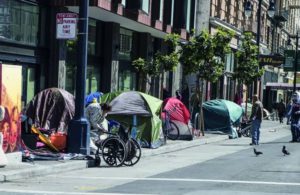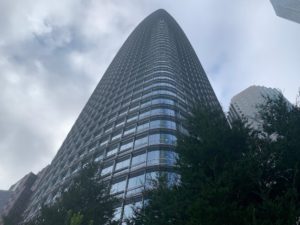Doom Loops Are Multiplying
Doom loops have been in the lexicon for a long time. The basic idea is the decline of one of the inputs holding up the status quo weakens the other inputs. This weakness feeds back on itself, accelerating the decline until a critical support level breaks and the system collapses.

Doom loops are being used to describe big-city downtowns gutted by remote work, the closure of small businesses and the rise of property crime and chronic homelessness. Once the workforce commuting to downtown fell sharply, the businesses catering to this workforce no longer had a customer base large enough to support them all and so many close.
This mass closure makes the district less vibrant, further weakening commerce.
At the same time, politicians and district attorneys have mandated non-prosecution of non-violent property crimes such as auto break-ins, shoplifting, etc., giving the green light to the criminal class that specializes in property crimes. This increase in property crime forces the closure of flagship retail outlets strip-mined by blatant shoplifting.
This shift in enforcement did little to stem the flood of fentanyl and other addictive narcotics into city centers, where the chronically homeless have congregated in sprawling encampments.
While mayors promote declines in violent crimes, they don’t mention the impact of human waste, drug-addled homeless and property crimes, many of which are not even reported as small business owners fear reporting losses due to break-ins might result in their insurance policies being canceled.
The closures of downtown businesses cause tax revenues to plummet, leaving less for policing and other essential services. Criminals quickly catch on and so break-ins occur when police patrols are absent.
Meanwhile, the decline in commuters has crushed transit agencies’ revenues, creating giant holes in billion-dollar budgets with few realistic solutions.
The solution being touted is to convert empty office buildings into residences, to replace commuting office workers with residents. This sounds feasible in the abstract, but these conversions are extremely costly, and the attractiveness of decaying downtowns to upscale residents is a question few entertain, for the answer is painfully obvious: who wants to live in a neighborhood of human waste, degradation, rampant property crimes and drugs, all of which have rendered local businesses unviable?
You can be sure the politicians and district attorneys whose policies exacerbated the decay won’t live downtown. Like the people who elected them, they live in wealthy enclaves that are so far protected from the consequences of doom loops.
Once the downtown has been stripped of targets, do you reckon the criminals who specialize in property crimes will retire? Or will they move into the enclaves where the protected class lives?
Another doom loop is gutting rural villages and towns globally. You’ve probably seen media reports of houses in Italian or Japanese villages that can be had for $1 or some nominal sum.
Left out of these chirpy accounts of $1 houses in charming villages are all the realities that generated the doom loop that hollowed out the villages in the first place: their remoteness, absence of jobs, the dominance of an aging populace of pensioners, decaying, outdated housing requiring costly renovations, the depreciating value of such properties, and so on.
Once the post office closes due to a decline in the populace and the elementary school closes due to a decline in enrollment, the village is doomed. Families with children move away, further reducing the populace, and pushing it below the thresholds needed to support a local temple/church priest, a local cafe, etc.
Doom loops are difficult to reverse. The current zeitgeist, which seems to only have two poles, complacency/denial, and panic, is not conducive to practical, realistic appraisals or plans of action, all of which require painful sacrifices and reductions in unsustainable spending to align with reduced revenues and prospects.
This zeitgeist encourages “constructive optics” and happy stories disconnected from the realities of the doom loops already in play. Yes, we can all pretend to be fantastic until the floor collapses beneath us. At that point, complacency/denial gives way to panic, but it’s too late to effect any realistic reversal of fortune.
Is San Francisco spiralling into an economic ‘doom loop’?

Few global office markets took as much as a hammering during the pandemic as San Francisco. The city’s biggest strength – its booming tech sector – turned out to be its biggest weakness as tech companies were one of the quickest sectors to embrace remote working.
The sector has also been one of the slowest to ask its workers to return to the office due to the ease with which most tasks can be done remotely.
According to data from Kastle Systems, which tracks US office footfall numbers, San Francisco has been the slowest US city to see workers return to the office, with a downtown occupancy rate of just 39% at the end of September last year.
So parlous was the situation as tech companies – and occupiers from other sectors – vacated office space that late last year, The Sunday Times claimed the city was blighted by ‘ghost offices’. Office data underlined the scale of the problem. At the end of Q4 last year, there was 24m sq ft of surplus space in downtown San Francisco, according to CBRE. This translates to a vacancy rate of 27.6%.
So, how likely is it that the city can turn things around? What are the chances of this empty office space attracting new occupiers – or finding new uses?
On the ground it didn’t look great when BE News visited at the end of 2022. Wandering around downtown San Francisco at lunchtime on a midweek day, the journalists could not believe how deserted the streets were. Pre-pandemic, it would have been a hive of activity. The ‘tech bros’ were noticeable by their absence.
A handful of tourists mooched around the impressive elevated Salesforce Park, but otherwise the streets were more or less empty of people and cars – other than the ubiquitous driverless cars, which performed loops of the empty streets without fear of wiping out pedestrians.
The knock-on effect of this mass exodus has caused retailers, large and small, to shut down shops. Ditto bars, restaurants and gyms. Retail and F&B vacancy rates in the area have soared over the last two years and there is little sign of improvement anytime soon. Even local property experts struggle to talk up the market.
“Our vacancy rate right now is the highest that it has ever been since we’ve been tracking this market in early 1980s,” says Colin Yasukochi, executive director of CBRE’s Tech Insights Center. “It’s also the largest change in the vacancy rate we’ve seen, because pre-pandemic, it bottomed out at about 4% and now it’s 27%. Sublease space was the biggest contributor to rising supply as office tenants decided they no longer need that much space or reduced space as part of cost containment measures.”
Unfortunately, the situation could get a lot worse before it gets better. Since BE News’ visit to the city last winter, a number of tech companies have announced major lay-offs, with Elon Musk’s Twitter shedding thousands of workers and Alphabet laying off 12,000 workers in January this year. Other tech companies large and small have made workers redundant over the last few months.
The current economic climate could create even more hardship for these businesses, warns Bradley Tisdahl, CEO of Tenant Risk Assessment, a financial analyst who represents numerous institutions owners and investors on their real estate throughout the US.
“The equity markets are falling and central bankers are raising rates and whenever rates go up, it’s textbook: tech goes down,” explains Tisdahl. “This is occurring exactly as anyone should expect it to occur and it will continue to occur if rates continue to go up. It has the potential to cool the economic activity of the whole region.”
That ‘cooling’ of the market has been exacerbated by the recent collapse of Silicon Valley Bank, which sent shockwaves through the tech and the banking industry.
“The collapse of the bank will yield challenges we can’t fathom yet today, but it highlighted the risks associated with tech, particularly in the rising rate environment, and brought to the forefront in real terms how risky and concentrated many of them are,” says Tisdahl.
“While it’s too soon to tell, I would imagine that the collapse of Silicon Valley Bank will cast a pall over the region’s CRE [commercial real estate] activity as it takes stock of the strength or vulnerabilities underlying tenants. It would seem though that with additional layoffs in recent months from Meta and Amazon and the possibility of more later this year, that the market is likely to remain cool.”
The issue the city faces is tech companies are not only among the biggest current occupiers of office space in San Francisco; they also have historically driven take-up. Pre-pandemic CBRE figures show tech companies accounted for more than 50% of office requirements on average, but in Q3 last year tech companies accounted for just one-third of office requirements, with many of the big tech firms putting their requirements on hold.
This is having a big impact on the downtown market, because while many of the larger tech companies such as Apple, Alphabet, Twitter and Facebook have their own self-contained campuses in Silicon Valley, San Mateo or San Jose, they have in more recent years also started to occupy lots of square footage in the downtown area.
“Most of the big companies that are headquartered in Silicon Valley have space here in the city as well because a large share of their employees are younger and they want to live in the city,” explains Yasukochi. “About five or so years ago, they realised that they were running buses back and forth [between the city and Silicon Valley] and their employees wanted to have the opportunity to be able to work in the city, and so many of them started opening up fairly large office buildings.”
Many of these businesses are now looking to sublease this space and there could be further pain on the horizon for landlords because CBRE’s data shows that leases on nearly 50% of the space that is being sub-let are due to expire in 2025, so suddenly the financial burden will shift from the occupier to the landlord.

Landlords are already investing in improving the amenity provision of buildings to retain and attract tenants and they’re also having to offer pretty hefty incentives to get deals over the line and maintain rental levels.
“What we are seeing from the office deals that are taking place in San Francisco is very similar to what we were seeing in New York and a lot of other major cities a year ago that were hard to hit by the pandemic, which is landlords are effectively buying their deals,” says Tisdahl. “So rents are going to stay pretty high and they [landlords] are going to give a lot of free rent or a lot of abatement.”
So what else can be done to address the problem and fill the current slew of vacant space office? One option is residential conversion. While in theory this sounds sensible given America’s shortage of housing, there are lots of caveats attached. For starters, many of the city’s high rise buildings are not suitable for conversion. It also costs a lot to convert offices to residential and it will have an impact on the values of these buildings.
“It’s something that everyone’s talking about and if there is a political will to make it take place, it’s possible that something like that could take place,” says Tisdahl. “It’s no secret that California has a housing crisis and there’s limited housing availability, so it could be very apt timing. But that capital [to pay for conversions] has to come from somewhere and converting an office into residential, beyond just the zoning issues, would probably require significant refitting of things like HVAC and plumbing, and a lot of work would need to be done to divide the existing space.
So, if there are suitable incentives in place for developers to do that then it possibly could occur, but at that point you’re making a long-term decision to say ‘these are no longer going to be office buildings, these are gonna be residential’ and that changes the whole nature of an urban centre, which is not a decision to come to lightly.”
While the data paints a pretty bleak picture of the office market in San Francisco, it is not the only US city that is struggling to recover from the pandemic. According to CBRE data, Portland, Denver and Dallas/Fort Worth, all had higher downtown vacancy rates at the end of Q3 last year.
Yasukochi adds that the vacancy rate in Q1 2020 was just 4% and San Francisco has seen vacancy rates in the past peak in the low 20s range, when there was a smaller amount of office stock in the city.
“Even though the situation does seem pretty dire right now, I’m optimistic about the tech industry having a way of reinventing itself and after every cycle the industry has come back stronger than before,” says Yasukochi. “And the pandemic has taught us is that we need more tech rather than less. So, once the situation settles out economically, our expectation is that they’re [tech companies] going to come back stronger than ever.”
Epilogue: in recent weeks, the San Francisco Chronicle newspaper reported that economists and urban planning experts believe a “doom-loop” scenario is possible in San Francisco, in which “connected forces send the city into an economic death spiral. For example, if workers stay remote and office buildings remain empty, then mass transit suffers from a lack of riders and workers needed for small businesses leave. That in turn hurts tax revenue, which spurs budget deficits, leading to cuts to city services. Those cuts hurt the city’s quality of life, which prompts more people to leave”. The paper’s editorial board argued that San Francisco needs a “strong vision for reinvention”.
yogaesoteric
June 27, 2023
